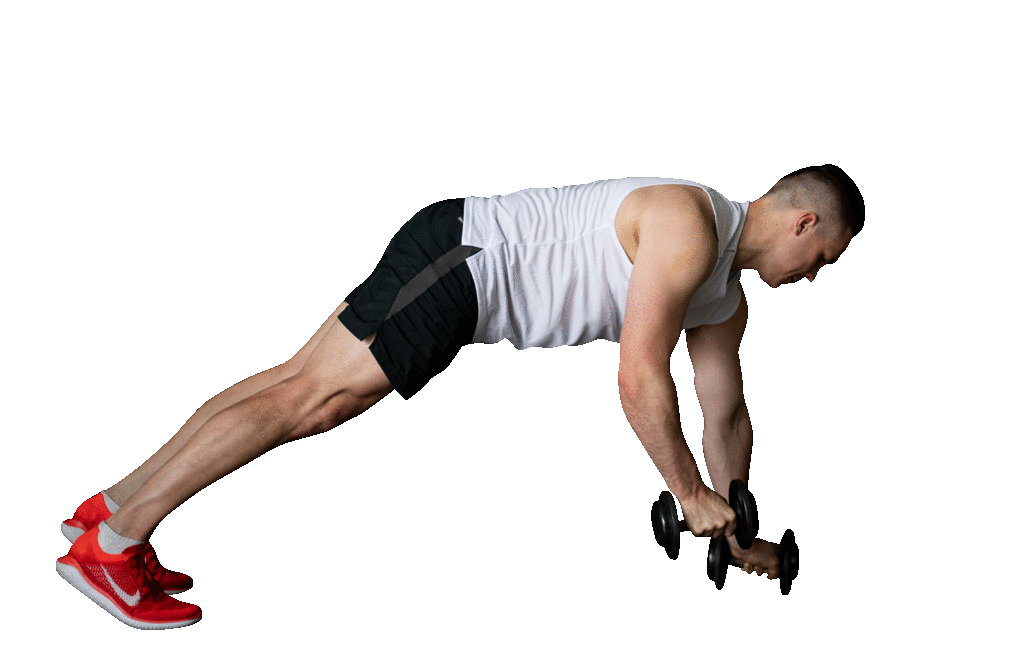Renegade rows have emerged as a dynamic and versatile exercise, revolutionizing the fitness landscape with their ability to engage multiple muscle groups simultaneously. Renegade rows, a pinnacle in modern fitness, redefine the boundaries of exercise by seamlessly combining strength and stability. As a cornerstone of full-body engagement, the renegade row with push-up introduces a dynamic fusion of movements, challenging the body from head to toe. Its versatility and effectiveness have garnered attention in the fitness community, making it a staple in comprehensive workout routines.
In this comprehensive guide, we will explore the mechanics, benefits, and variations of renegade rows, shedding light on the unique fusion of strength, stability, and full-body activation they offer.
Understanding Renegade Rows
Renegade rows, often referred to as the Dumbbell Renegade Row, stand out as a multifaceted compound exercise that has become integral to contemporary workout routines. This engaging movement seamlessly merges the stability of a plank with the strength-building dynamics of a row, delivering a holistic challenge to the upper body and core. Furthermore, the renegade row can be elevated by incorporating a push-up, creating a powerhouse workout known as the renegade row with push-up.
Muscles Engaged in Renegade Rows

-
Upper Back (Latissimus Dorsi, Rhomboids, and Traps)
- Renegade rows target the upper back muscles, including the latissimus dorsi, rhomboids, and traps. This engagement contributes to enhanced posture, improved shoulder stability, and the development of a well-defined back.
-
Shoulders (Deltoids)
- The deltoids are actively involved in the lifting phase of renegade rows. Strengthening the shoulders promotes overall upper body strength and contributes to a more sculpted appearance.
-
Arms (Biceps and Triceps)
- The biceps and triceps play a supportive role in stabilizing and controlling the dumbbells during the rowing motion. This engagement aids in comprehensive arm development.
-
Core (Rectus Abdominis, Transverse Abdominis, and Obliques)
- Renegade rows are exceptional for core activation. The plank position necessitates intense engagement of the rectus abdominis, transverse abdominis, and obliques, fostering core stability and strength.
-
Chest (Pectoralis Major)
- When coupled with the push-up variation, renegade rows extend their influence to the chest muscles. This dual action contributes to chest development and a more complete upper body workout.
How to Do Renegade Rows with Dumbbells?

Renegade Rows are a powerful full-body exercise that combines strength and stability. Executing this exercise with proper form is key to maximising its benefits. Here's a step-by-step guide on how to perform Renegade Rows:
- Begin in a plank position with your hands gripping a pair of dumbbells. Place the dumbbells directly beneath your shoulders, and ensure your body forms a straight line from head to heels.
- Your feet should be slightly apart to provide a stable base.
- Position your hands on the dumbbells with a firm grip. The wrists should be in a neutral position to maintain joint integrity.
- Engage your core muscles by tightening your abdominal muscles. This is crucial for stability and preventing your hips from sagging.
- Initiate the rowing motion by pulling one dumbbell towards your hip. Keep your elbow close to your body, engaging the muscles of your upper back, including the latissimus dorsi and rhomboids.
- Focus on squeezing your shoulder blades together at the top of the movement.
- Lower the dumbbell back to the ground with control. The descent phase is just as important as the lift, maintaining a stable plank position throughout.
- Alternate sides by performing the row with the opposite arm. This creates a balanced workout and prevents muscle imbalances.
- Continue to maintain a straight line from head to heels as you switch sides.
By following these steps, you'll execute Renegade Rows with proper form, targeting multiple muscle groups, including the upper back, core, chest, and arms. Incorporate this exercise into your routine for a comprehensive upper body workout with added core stability benefits.
Benefits of Renegade Rows
Functional Strength
Renegade rows mimic real-world movements, enhancing functional strength essential for daily activities and sports.
Improved Posture
Strengthening the upper back muscles contributes to better posture, reducing the risk of slouching and related issues.
Efficient Core Activation
Renegade rows are unparalleled in their ability to engage and strengthen the entire core, promoting stability and balance.
Upper Body Sculpting
The comprehensive engagement of upper body muscles leads to a sculpted and well-defined physique.
Time-Efficient Workouts
Renegade rows efficiently target multiple muscle groups, making them a valuable addition to time-constrained workout routines.
In conclusion, the dumbbell renegade row, especially when enhanced with the push-up variation, is a versatile and powerful exercise that offers a myriad of benefits. Understanding the targeted muscles and the associated advantages provides insight into the holistic impact this compound movement can have on one's fitness journey. Incorporate renegade rows wisely into your workout routine to experience a challenging and rewarding full-body workout.
Variations and Alternatives to Enhance Your Workout Routine
Renegade rows offer a dynamic and effective way to target various muscle groups, but it's essential to keep your fitness routine diverse and challenging. Here are some variations and alternatives to complement and intensify your workouts:
1. Kettlebell Renegade Rows

Instead of using dumbbells, perform renegade rows with kettlebells, challenging your grip strength and wrist stability.
Kettlebells provide an unstable load, requiring increased muscle engagement for stabilization.
2. Alternating Renegade Rows

Perform a traditional renegade row but alternate lifting each dumbbell with each repetition. This variation maintains constant tension on the muscles and adds a layer of endurance to your workout.
3. Push-Up to Renegade Row Flow
Combine push-ups and renegade rows in a seamless flow, transitioning between the two movements.
This dynamic flow enhances cardiovascular conditioning while maintaining the benefits of the individual exercises. This dynamic combination not only adds an extra challenge to the upper body but also engages the chest and triceps, transforming the workout into a full-body powerhouse.
4. Elevated Renegade Rows

Elevate your feet on a bench or box during renegade rows to increase the difficulty. It targets the muscles from a different angle and adds intensity to the exercise.
5. TRX Row

Set up a TRX suspension trainer at chest height. Hold the handles, lean back, and perform a rowing motion by pulling your body towards the handles.
6. Face Pulls

Attach a rope to a cable machine at face height. Grab the ends of the rope with both hands and pull it towards your face, targeting the rear deltoids and upper back.
7. Renegade Rows with Burpees
Integrate burpees into the renegade row sequence, combining strength training with a full-body conditioning exercise. This Elevates heart rate, burns more calories, and enhances cardiovascular fitness.
Choosing the Right Variation
Select variations based on your fitness level, goals, and any specific considerations such as existing injuries. Incorporating a mix of these renegade row variations and alternatives ensures a well-rounded and challenging workout routine. Always prioritise proper form, gradually progress the intensity, and listen to your body to achieve optimal results while minimising the risk of injury.
Answering Common Questions about Renegade Rows
Q. Can Renegade Rows be Done on Knees?
A: Yes, the traditional form of Renegade Rows is performed from a plank position. However, beginners or individuals with limitations can modify the exercise by performing it on their knees. This modification helps reduce the load on the core and upper body, making it more accessible for those who may find the plank position challenging.
Q. What is the Correct Form for Renegade Rows?
A:To maintain the correct form for Renegade Rows, follow these guidelines:
- Start in a plank position with hands directly under your shoulders.
- Keep your body in a straight line from head to heels.
- Engage your core to stabilise your body.
- Avoid excessive hip rotation by keeping your hips square to the ground.
- Adhering to these form principles ensures effective targeting of the muscles and minimises the risk of injury.
Q. Does Renegade Row Work Abs?
A:Yes, Renegade Rows are excellent for working the core muscles, including the abs. The exercise engages the core to stabilise the body during the rowing motion, providing a challenging workout for the abdominal muscles. Consistent incorporation of Renegade Rows into a fitness routine can contribute to improved core strength and stability.
Q.Do Renegade Rows Build Muscle?
A: Yes, Renegade Rows are effective for building muscle, particularly in the upper back, shoulders, and core. The rowing motion targets the muscles in the back and shoulders, while the plank position engages the core. As a compound exercise, Renegade Rows promote muscle development and can be a valuable addition to a strength-training program. Adjusting the weight and intensity allows individuals to tailor the exercise to their fitness level and goals.
Conclusion
Renegade Rows have revolutionised fitness, offering a dynamic, versatile exercise that merges strength and stability. The compound movement, especially with the push-up variation, challenges the entire body, becoming a cornerstone in comprehensive workouts. This guide explored mechanics, benefits, and variations, emphasising the engagement of upper back, shoulders, arms, core, and chest. Renegade rows enhance functional strength, posture, core activation, upper body sculpting, and time-efficient workouts.
Incorporating renegade rows, guided by proper form, into routines promises a rewarding, full-body workout. The comprehensive guide also introduced variations like kettlebell renegade rows and push-up to renegade row flows, ensuring diverse and challenging workouts. Answering common questions clarified that renegade rows on knees are permissible, outlined correct form principles, affirmed its effectiveness for abs, and highlighted its muscle-building prowess. Renegade rows stand as a valuable addition, adaptable to various fitness levels and goals, offering holistic benefits in strength training.










